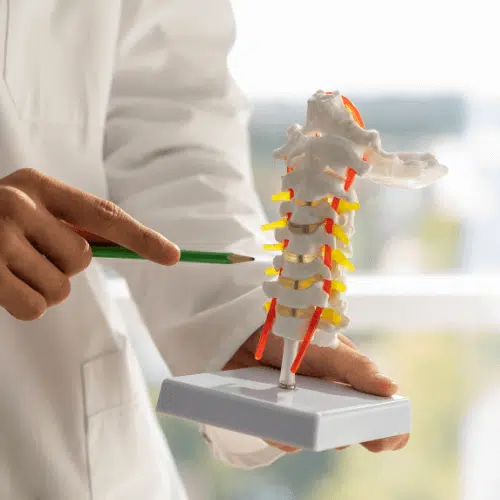Usual Treatments Carried Out by the Best Spine Surgeons in St Louis MO
Wiki Article
An Overview of Spine Problems That Commonly Lead To Surgical Treatments
Spinal column conditions such as herniated discs, back constriction, and degenerative disc condition frequently necessitate surgical treatments when traditional treatments fall short to reduce relentless symptoms. These problems not just cause substantial pain but can likewise drastically hinder everyday performance and overall lifestyle. Understanding the nuances of each condition and the equivalent surgical choices, such as discectomy or back fusion, is important for effective management. As we check out these problems additionally, it becomes evident that the decision-making process bordering medical therapy is complex and warrants cautious factor to consider.Herniated Discs
Although many individuals with herniated discs might find alleviation via conservative treatments, surgical procedure comes to be a needed consideration when signs and symptoms intensify or linger - best spine surgeons in st louis mo. A herniated disc happens when the soft internal gel of a spine disc sticks out via its outer layer, potentially leading and compressing neighboring nerves to discomfort, feeling numb, or weak point in the extremitiesTraditional management typically includes physical treatment, pain medicines, and corticosteroid injections, which aim to decrease swelling and improve feature. Nevertheless, in situations where these approaches fail to reduce devastating signs and symptoms, surgical options may be explored.
The most typical surgery for herniated discs is a discectomy, which involves the removal of the herniated section of the disc to relieve pressure on the impacted nerve origin. In more extreme situations, spinal combination may be needed to maintain the impacted vertebrae.
Clients are recommended to discuss the potential risks and benefits of surgical treatment with their doctor to make an educated choice. Inevitably, the objective of any surgical intervention is to restore function, minimize pain, and boost overall lifestyle for people suffering from herniated discs.
Spine Stenosis
Spine constriction occurs when the rooms within the back narrow, resulting in raised stress on the spinal cord and nerves. This problem can develop in various regions of the back, consisting of the cervical and back locations, often due to age-related changes, such as degenerative disc condition, joint inflammation, or enlarging of tendons.Individuals with spine stenosis may present with symptoms that consist of discomfort, tingling, prickling, or weakness, primarily in the arms or legs. These signs can be worsened by activities that involve standing or strolling, usually leading individuals to look for relief via conservative therapies like physical treatment, medications, or epidural steroid injections.
Nevertheless, when these non-surgical treatments stop working to give sufficient alleviation, surgical alternatives might be taken into consideration. Usual procedures for spinal constriction include laminectomy, which includes the removal of component of the vertebra to reduce stress, and spine fusion, which maintains the afflicted area. The choice to go after surgical treatment is commonly based upon the seriousness of symptoms, the degree of practical impairment, and the overall wellness of the person. Motivate diagnosis and management are critical to protect against more neurological concession and boost high quality of life.
Spondylolisthesis
Spondylolisthesis takes place when one vertebra slips forward over an additional, leading to misalignment of the spinal column. This problem can arise from numerous factors, including hereditary issues, trauma, or degenerative changes in the spinal column. It is most frequently observed in the back area, specifically at the L4-L5 and L5-S1 degrees.
Treatment options differ based on the severity of the slippage and the symptoms presented. Conservative procedures, consisting of physical therapy, discomfort monitoring, and activity adjustment, are often the very first line of defense. Nevertheless, click to read more when non-surgical approaches fall short to relieve signs and symptoms or when substantial nerve compression is present, surgical treatment may be warranted. Surgical options can consist of back fusion or decompression procedures, focused on bring back positioning and easing neurological signs. Early diagnosis and appropriate monitoring are critical for optimum outcomes in individuals with spondylolisthesis.
Degenerative Disc Disease

People with DDD typically experience pain that may emit to the legs or arms, depending upon the influenced area of the spine. The problem can be identified through a combination of professional examination, imaging research studies, and patient history. Therapy choices generally start with conventional measures, consisting of physical therapy, discomfort management, and way of living adjustments. When these techniques fall short to offer sufficient alleviation, surgical treatments might be considered.
Surgical choices for DDD may consist of spinal blend or synthetic disc replacement, targeted at stabilizing the influenced section and reducing discomfort (best spine surgeons in st louis mo). Eventually, the selection of treatment is embellished, taking into consideration the severity of the problem, client health and wellness, and way of living aspects
Spinal Lumps

What variables contribute to the growth of growths within the back, and exactly how do they show up in people? Back tumors can emerge from various variables, including genetic tendency, environmental impacts, and pre-existing clinical problems. They can be categorized as main lumps, originating in the spine, or second lumps, which spread out from various other areas of the body. Patients may provide with a variety of signs and symptoms, including localized pain, neurological shortages, weakness, or changes in digestive tract and bladder feature, depending upon the growth's size and area.
Surgical treatment may be necessitated to minimize signs, obtain a biopsy, or eliminate the tumor entirely. The goal of surgical treatment is typically to decompress neural elements and support the spinal column. Early discovery and intervention are vital for optimizing results in individuals with spine growths.
Verdict
In recap, spine problems such as herniated discs, This Site back stenosis, spondylolisthesis, degenerative disc disease, and spinal lumps frequently require medical intervention because of their potential to create substantial pain and useful problems. While conservative treatments might offer temporary alleviation, medical choices end up being important when signs persist or aggravate. Timely diagnosis and intervention play an essential role in recovering feature and enhancing the lifestyle for damaged individuals, underscoring the relevance of extensive back care.
Report this wiki page